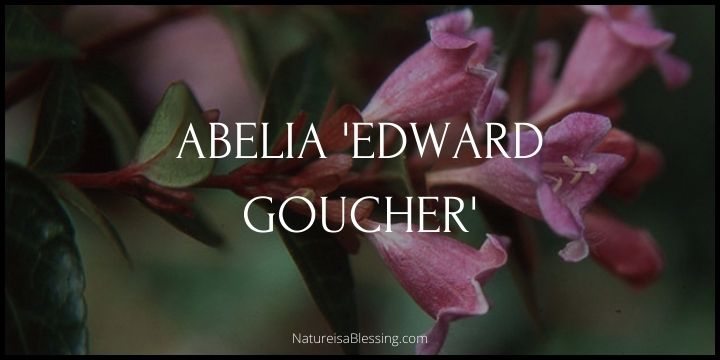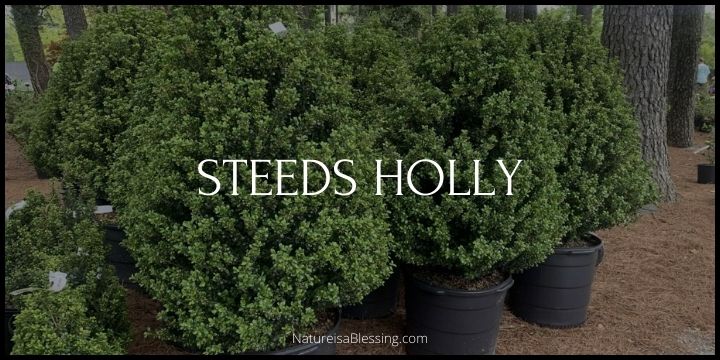Junipers: Tips to Planting, Growing & Caring
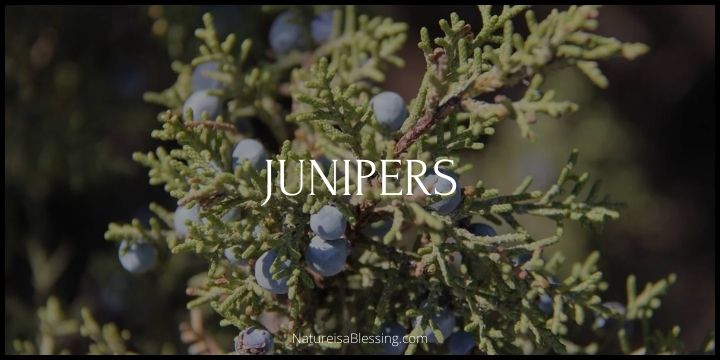
What are Junipers?
Junipers are a type of coniferous plant in the genus Juniperus in the cypress family Cupressaceae. They are native to various regions across the Northern Hemisphere, from Arctic areas to tropical Africa and Central America.
The most distinctive characteristic of junipers is their aromatic, needle-like or scale-like foliage. The leaves are either small and needle-like or scale-like and arranged in opposing pairs or whorls of three.
Junipers can range in size and form from tall trees that reach heights of 10-40 meters, to columnar or low-spreading shrubs with long trailing branches, often turning into dense groundcovers.
Junipers produce seed cones that are often popularly referred to as “berries”, though they are not true berries but a cone with unusually fleshy and merged scales. These “berries” are usually blue or violet and are a food source for many birds and other wildlife.
They are often used in landscaping and horticulture due to their hardy nature and aesthetic appeal. Some species are also used to flavor food and drinks — for instance, the juniper berry is a key ingredient in making gin.
Fast Facts About Junipers
| Attribute | Description |
|---|---|
| Country Or Region Of Origin | Junipers are native to various regions across the Northern Hemisphere, from Arctic areas to tropical Africa and Central America. |
| Plant Type | Junipers are evergreen shrubs or trees. |
| Family | Junipers belong to the Cupressaceae family. |
| Genus | The genus is Juniperus. |
| Sun Exposure | Junipers thrive best in full sun, but they can tolerate partial shade. |
| Season of Interest | They provide year-round interest due to their evergreen nature. |
| Water | Junipers prefer dry to medium moisture levels. Once established, they are highly drought tolerant. |
| Maintenance level | Generally, junipers are low-maintenance plants. |
| Growth rate | Depending on the species, growth rates can vary from slow to moderate. |
| Height | Junipers range in size from low-growing ground covers to tall trees that can reach up to 40 meters. |
| Spread | The spread of a juniper can be anywhere from 1 meter for smaller varieties to over 8 meters for larger tree types. |
| Spacing | For planting, spacing will depend on the specific variety and its mature width. |
| Soil Type | Junipers are adaptable to a wide range of soil types, but they prefer well-drained soils. |
| Soil pH | They can tolerate a wide pH range, from acidic to slightly alkaline. |
| Soil Drainage | Junipers require well-drained soil conditions. |
| Habit/Form | Junipers can be upright, spreading, or weeping in form. |
| Attracts | Birds are attracted to the berries, and certain species of butterflies use junipers as a larval host. |
| Characteristics | Junipers are known for their attractive, needle-like or scale-like foliage and aromatic scent. They produce seed cones often referred to as “berries”. |
| Tolerance | Junipers are highly tolerant of drought, wind, deer, and salt. |
| Suggested Use | Junipers are versatile and can be used for ground cover, windbreaks, screens, or specimen plants in the landscape. |
| USDA Plant Hardiness Zone | Depending on the species, junipers are hardy from USDA zones 2 to 9. |
The 12 Most Popular Types of Junipers
| Type of Juniper | Description | USDA Zones |
|---|---|---|
| All Gold Shore Juniper | This type of juniper has golden-yellow foliage and is often used as a ground cover. | 6-8 |
| Blue Pacific Juniper | Known for its dense, spreading branches, this juniper has blue-green foliage. | 5-9 |
| Blue Rug Juniper | This low-growing juniper makes an excellent ground cover with its silver-blue foliage. | 4-9 |
| Dwarf Japanese Garden Juniper | This variety features beautiful blue-green foliage and is often used for bonsai. | 5-9 |
| Angelica Blue Juniper | This juniper variety has striking silver-blue foliage and a pyramidal form. | 4-9 |
| Azores Juniper (Juniperus brevifolia) | Native to the Azores, this juniper species is known for its unique, irregular shape. | 9 |
| Canary Islands Juniper (Juniperus cedrus) | This species, native to the Canary Islands, is known for its distinctive, peeling bark and berries used in traditional medicine. | 8-9 |
| Eastern prickly juniper (Juniperus oxycedrus) | This juniper is known for its sharp, prickly leaves and its red-brown or grey bark. | 8-10 |
| Spartan Juniper | The Spartan Juniper is popular for its fast growth rate and pyramidal shape. It’s often used as a privacy screen. | 4-9 |
| Hollywood Juniper | Known for its twisted, sculptural form, the Hollywood Juniper is a popular choice for adding interest to the landscape. | 5-9 |
| Common Juniper (Juniperus communis) | This species is widespread and versatile, with varieties that can be used as tall trees, shrubs, or ground covers. Its berries are commonly used to flavor gin. | 2-6 |
| Chinese Juniper (Juniperus chinensis) | This species is native to northeast Asia and comes in many forms, from low spreading shrubs to tall trees. It’s often used in bonsai. | 3-9 |
1. All Gold Shore Juniper
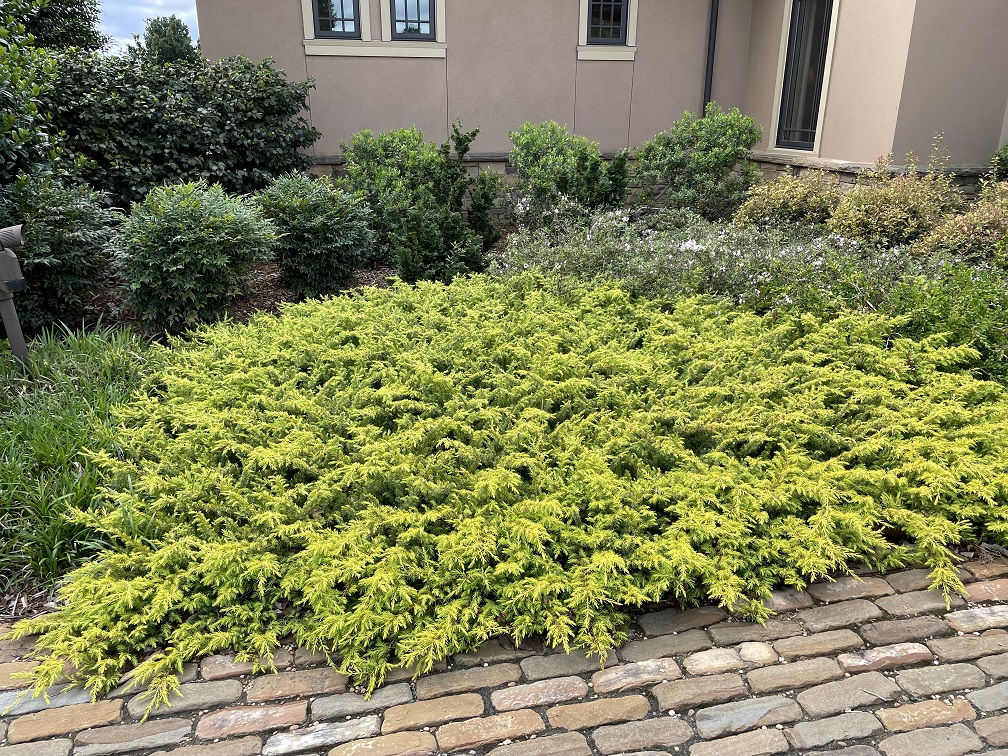
The All Gold Shore Juniper, scientifically known as Juniperus conferta ‘All Gold’, is a vibrant and hardy evergreen shrub that adds a dash of golden color to any landscape.
This low-growing juniper variety is known for its striking, needle-like foliage that shines in a bright, golden-yellow hue year-round. With a sprawling growth habit, it makes an excellent ground cover, reaching up to 1 foot in height and spreading about 5 feet wide.
It thrives in full sun and well-drained soil, and it’s highly tolerant of seaside conditions, making it a great choice for coastal gardens.
The All Gold Shore Juniper is also drought-tolerant once established and requires little maintenance, making it an easy and versatile option for both novice and experienced gardeners seeking to add some color to their outdoor space.
2. Blue Pacific Juniper
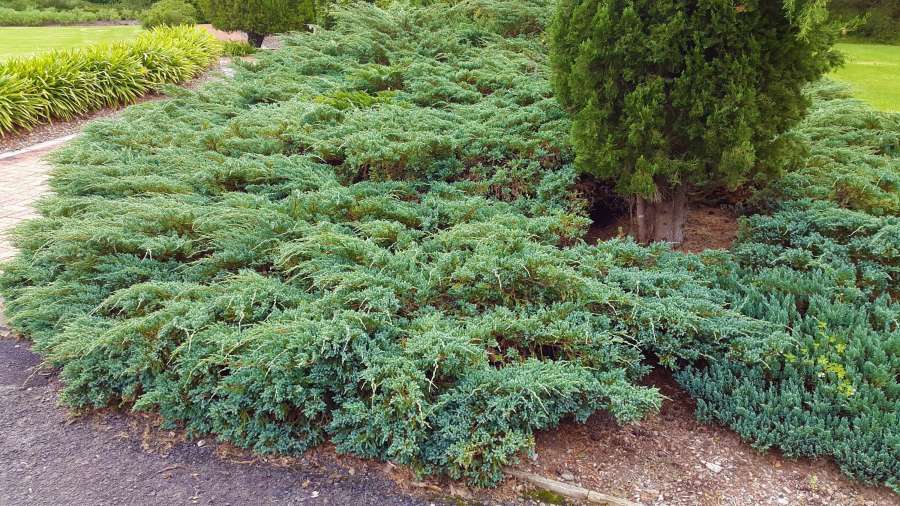
The Blue Pacific Juniper, or Juniperus conferta ‘Blue Pacific’, is a popular evergreen shrub known for its lush, silvery-blue foliage and robust, low-spreading growth habit.
Often reaching heights of just 1 foot, but spreading up to 6-8 feet wide, it makes an excellent ground cover, ideal for slopes and banks where it can help control soil erosion.
This juniper variety thrives in full sun and adapts well to a variety of soil types, provided they are well-drained. It’s also highly tolerant of salt spray and drought once established, making it a great choice for coastal landscapes and xeriscaping.
With its soft, feathery texture and striking color, the Blue Pacific Juniper adds visual interest to the garden year-round, while requiring minimal maintenance, making it a favorite among both landscapers and homeowners.
3. Blue Rug Juniper
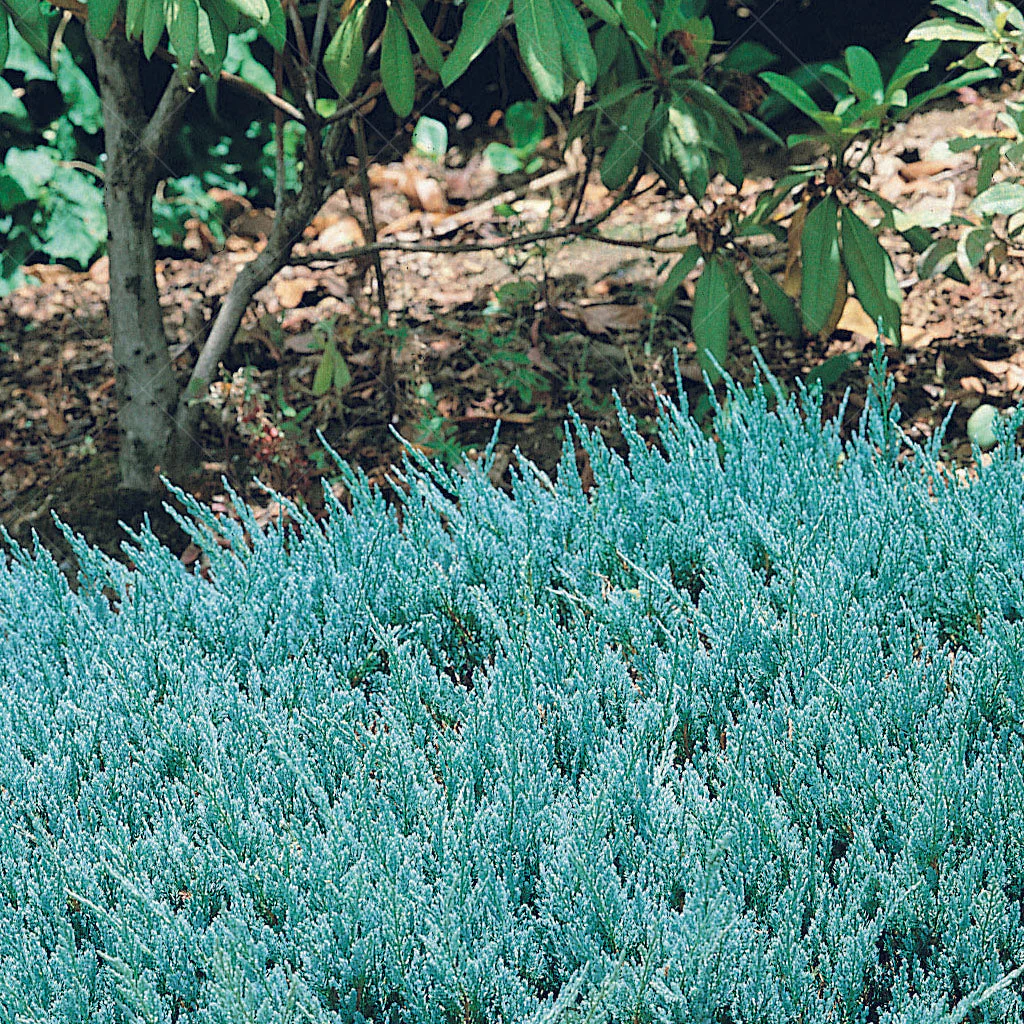
The Blue Rug Juniper, or Juniperus horizontalis ‘Wiltonii’, is a hardy evergreen shrub highly prized for its dense, carpet-like growth and stunning silver-blue foliage.
As the name suggests, this juniper variety grows low to the ground, typically reaching heights of only 4 to 6 inches, but spreading as wide as 6 to 8 feet.
This makes it an excellent choice for ground cover, erosion control on slopes, or cascading over walls. The Blue Rug Juniper thrives in full sun and can adapt to a variety of soil conditions, including rocky or sandy soils, as long as they are well-drained.
It’s also notably drought-tolerant and resistant to deer, making it a low-maintenance option for many landscapes. Its vibrant color and texture provide year-round interest, particularly in winter when the foliage takes on a purplish hue.
4. Dwarf Japanese Garden Juniper
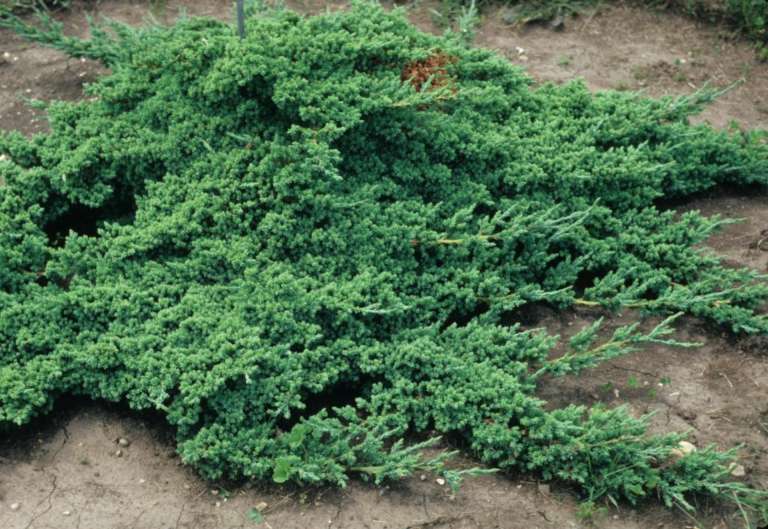
The Dwarf Japanese Garden Juniper, scientifically known as Juniperus procumbens ‘Nana’, is a compact evergreen shrub cherished for its attractive, dense green foliage and ground-hugging growth habit.
Typically reaching heights of about 1 foot and spreading up to 6 feet wide, this dwarf juniper variety makes an excellent ground cover, especially in rock gardens and on slopes for erosion control.
The plant’s short, needle-like leaves provide year-round color, turning slightly purple in colder months. The Dwarf Japanese Garden Juniper is highly adaptable, thriving in full sun to partial shade and in various soil types, as long as they are well-drained.
It’s also drought-tolerant once established and generally resistant to pests and diseases, making it a low-maintenance addition to any landscape. With its unique bonsai-like appearance, this juniper variety also makes a stunning specimen plant or container plant.
5. Angelica Blue Juniper
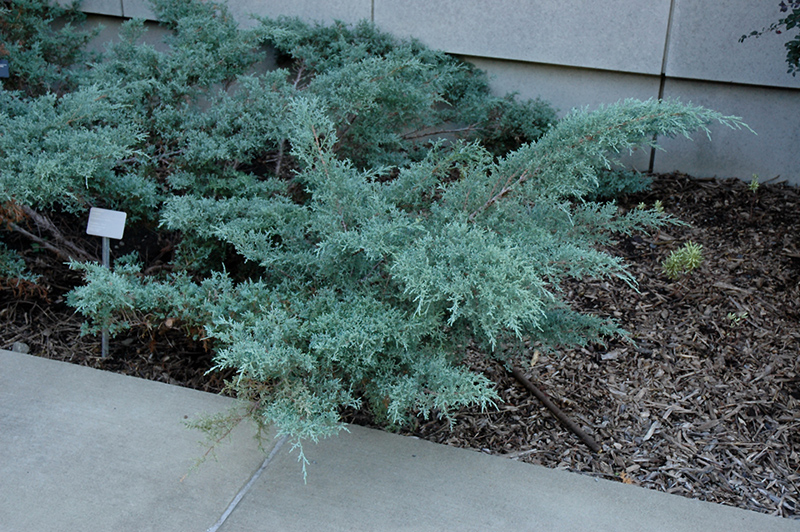
The Angelica Blue Juniper, also known as Juniperus chinensis ‘Angelica Blue’, is an evergreen shrub renowned for its striking blue-green foliage and pyramidal growth habit.
This juniper variety can reach heights of up to 15 feet and widths of around 8 feet, making it an excellent choice for creating privacy screens or windbreaks. Its dense, feathery foliage provides year-round color and texture, becoming even more vibrant under full sun exposure.
The Angelica Blue Juniper is adaptable to a range of soil types, as long as they are well-drained, and exhibits good drought-tolerance once established.
It’s also resistant to most pests and diseases, offering a low-maintenance landscaping solution. With its stunning color and architectural form, this juniper variety adds a distinct focal point to any garden or landscape design.
6. Azores Juniper (Juniperus brevifolia)
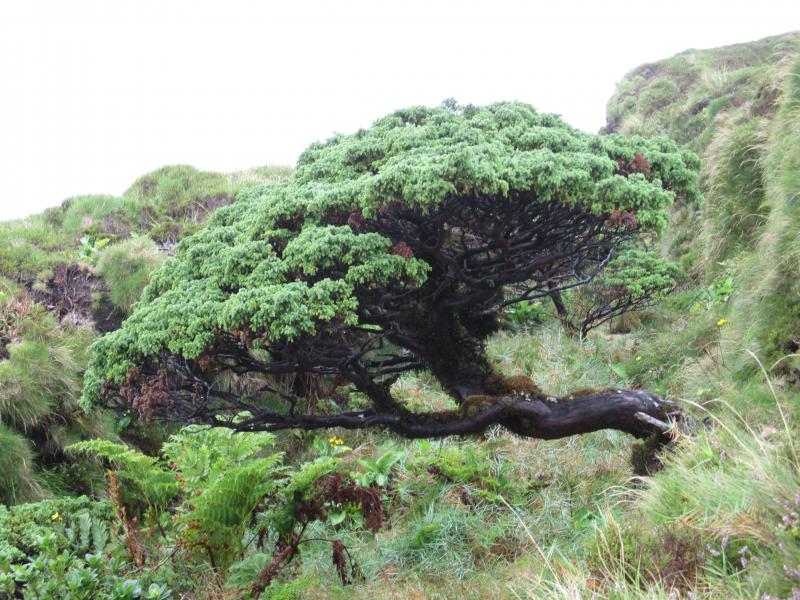
The Azores Juniper, scientifically known as Juniperus brevifolia, is a unique species of juniper endemic to the Azores islands. It thrives at elevations between 240 and 800 meters and is a crucial part of the local ecosystem.
This evergreen tree or shrub features a pyramidal form, reaching up to 6 meters (19.68 feet) in height. The plant is dioecious, meaning that individual plants are either male or female.
The Azores Juniper is listed as vulnerable by the International Union for Conservation of Nature (IUCN), highlighting the importance of conservation efforts.
Interestingly, the plant has both ornamental and cultural significance, with some European cultures traditionally hanging cuttings over doorways as part of May Day celebrations.
7. Canary Islands Juniper (Juniperus cedrus)
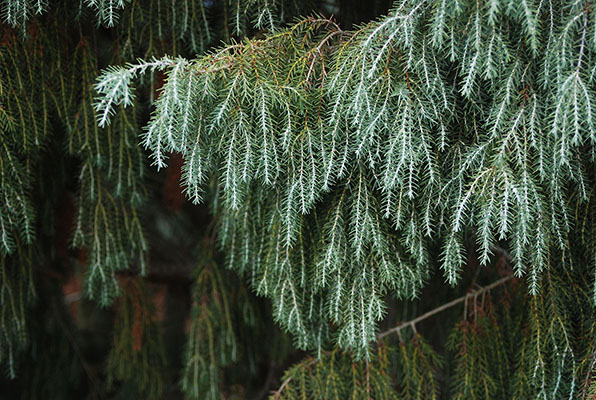
The Canary Islands Juniper, also known as Juniperus cedrus, is a distinct species of juniper native to the western Canary Islands and Madeira.
This evergreen tree or large shrub typically grows to a height of 5-20 meters, with some individuals reaching up to 25 meters. It features outspread branches, a short thick trunk, and pendulous branchlets, giving it an attractive and unique appearance.
The leaves are evergreen, providing year-round greenery. This juniper species can be found in the most remote crags of Montaña del Cedro in the Guguy area of Gran Canaria, where the only natural population survives.
It’s also seen on the Canadas del Teide in Tenerife. Its bark is orange-brown and peels in vertical strips. Notably, some of these junipers found on vertical cliffs have been dated to be millennia-old. However, the Canary Islands Juniper is listed as threatened, highlighting the need for conservation efforts.
8. Eastern prickly juniper (Juniperus oxycedrus)
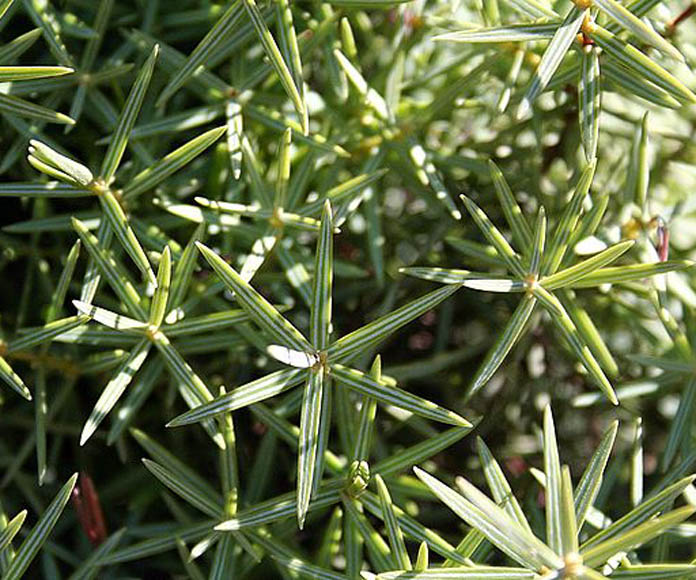
The Eastern Prickly Juniper, scientifically known as Juniperus oxycedrus, is a species of juniper native to the Mediterranean region and the Middle East. Also known as Cade, prickly cedar, or sharp cedar, this small coniferous tree or shrub stands out with its distinctive prickly leaves and berries.
The tree can grow up to 15 meters (49 feet) at a medium growth rate, showcasing its adaptability and resilience.
Its leaves are between 10 and 20 mm, and the cones, which are often mistakenly referred to as berries, have medicinal properties. The plant’s hardiness makes it suitable for growth in a variety of climates, including up to UK zone 7.
Beyond its physical attributes, the Eastern Prickly Juniper also has cultural significance, particularly in the context of traditional medicine where its oil is used for its therapeutic properties.
9. Spartan Juniper
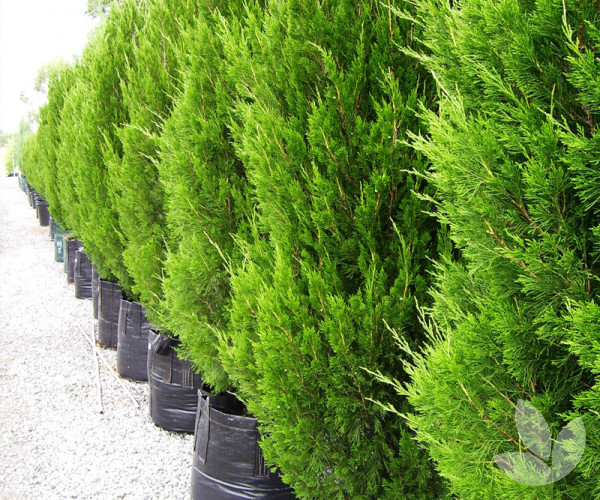
The Spartan Juniper, known scientifically as Juniperus chinensis ‘Spartan’, is a fast-growing evergreen native to regions including China, Japan, Mongolia, and the Himalayas.
This plant is noted for its stately, dark green, densely branched columnar form. It’s an excellent choice for use as a formal accent, screen, or windbreak in landscaping due to its handsome appearance and resilience.
The Spartan Juniper features a naturally pyramidal growth habit, requiring no pruning. Once mature, unpruned Spartan Junipers can reach widths of 4-5 feet and heights of 15-20 feet. The foliage is lush, dark green, and quite dense, making it a wonderful privacy screen. This species is dioecious, meaning it has separate male and female plants.
This tree is not only attractive but also highly durable, making it a popular choice among gardeners. Its adaptability and toughness add to its appeal, as it’s able to thrive in a variety of conditions.
10. Hollywood Juniper
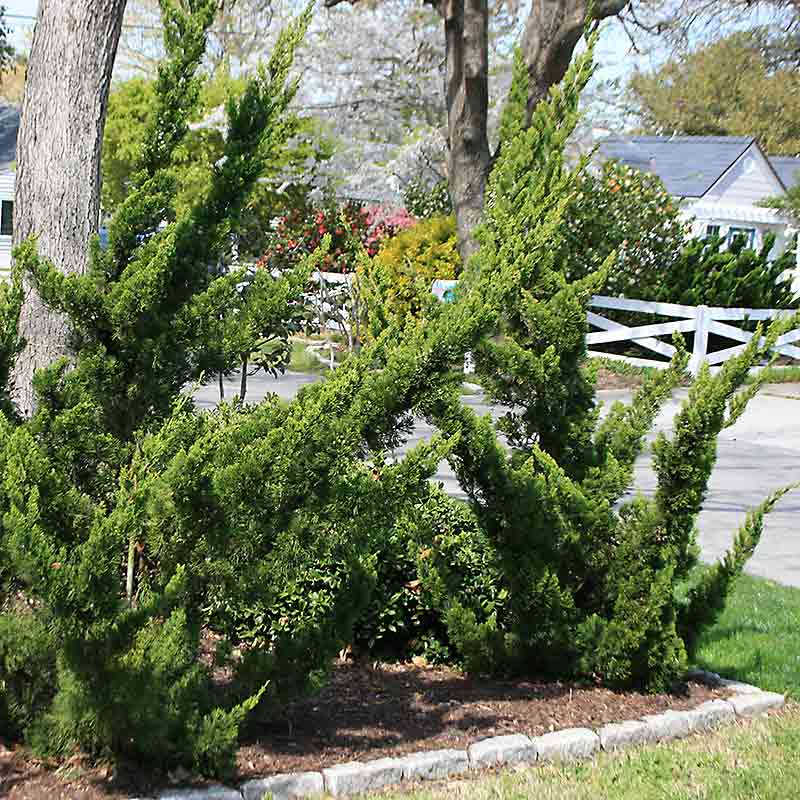
The Hollywood Juniper, classified as Juniperus chinensis ‘Torulosa’ or ‘Kaizuka’, is a distinctive evergreen tree or large shrub known for its naturally twisted, upright spiraling growth. This plant, which originated in East Asia, has garnered popularity in Los Angeles gardens, hence its common name “Hollywood”.
Growing up to 20-30 feet high, this unique tree showcases deep green colors and irregular branches that make it particularly striking. The plant is highly adaptable and resilient, with salt and heat tolerance, which makes it popular not just in California but also in other southern states and the southwest region. It’s also known for its heat and drought tolerance.
The Hollywood Juniper is a low-maintenance plant that grows across a broad perennial range. Each Hollywood Juniper plant offers a unique appearance, making it a special addition to any landscape. It serves as an excellent accent for formal gardens and topiary specimens and can grow up to 15 feet tall and 10 feet wide in an irregular shape.
11. Common Juniper (Juniperus communis)

Juniperus communis, also known as the Common Juniper, is a versatile species of small tree or shrub belonging to the cypress family Cupressaceae. This evergreen conifer is possibly the most widely distributed tree in the world, found typically in dry, rocky areas across different climates.
The Common Juniper is highly variable in form, most often growing as a low, spreading shrub, but occasionally reaching up to 10 meters tall. It is characterized by its needle-like leaves and dioecious nature, meaning it has separate male and female plants.
This resilient plant is resistant to browse and can grow in a variety of challenging conditions. It’s frequently planted for hedgerows and topiary due to its ability to withstand diverse environments. From its medicinal properties to its use in flavoring gin, the Common Juniper holds cultural, culinary and therapeutic significance.
12. Chinese Juniper (Juniperus chinensis)
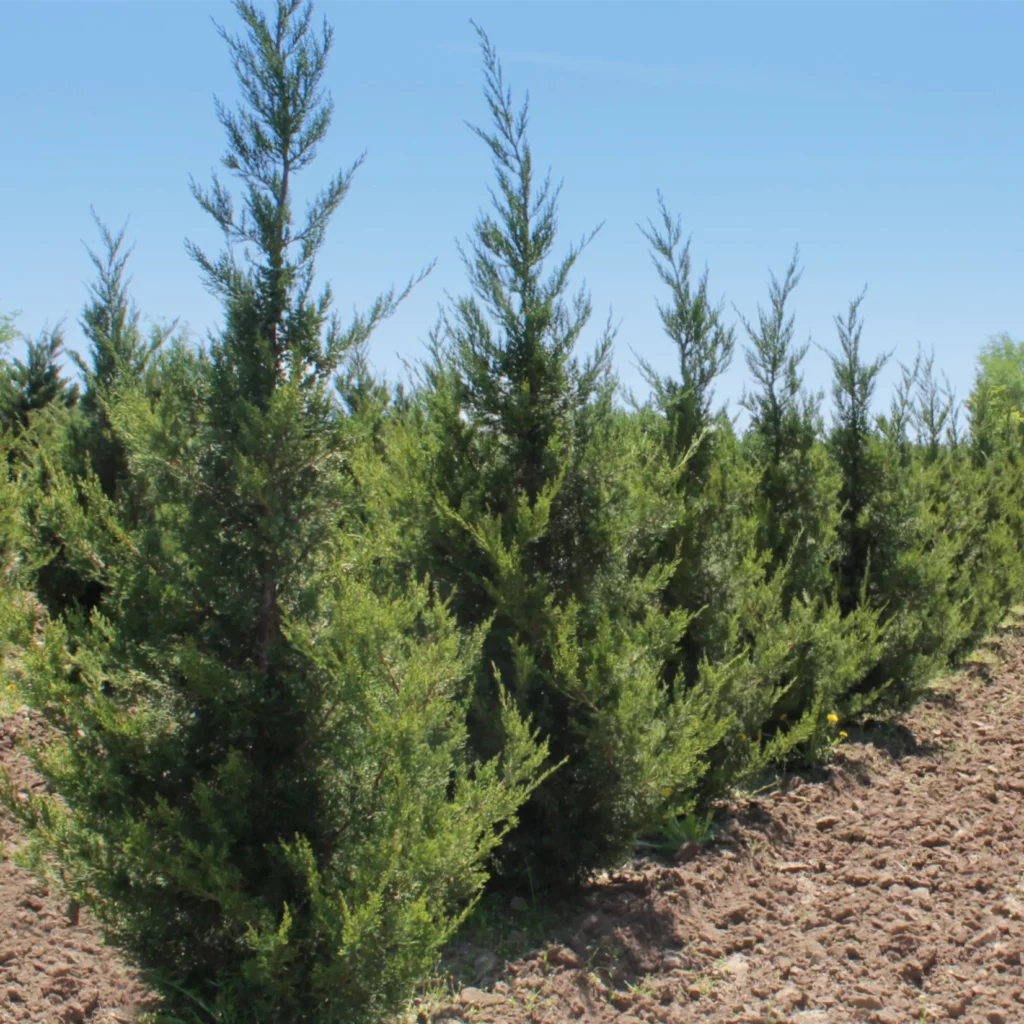
Juniperus chinensis, known as the Chinese Juniper, is a versatile evergreen conifer native to East Asia, including China, Japan, Mongolia, and the Himalayas. This plant can take the form of a tree or a wide-spreading shrub, reaching up to 50-60 feet in height and spreading 15-20 feet wide.
The Chinese Juniper is celebrated for its adaptability and durability, capable of thriving in dry, alkaline, or windy sites. It’s an excellent choice for year-round color, structure, and screening in a landscape. The foliage of this plant ranges from light to medium green, with some varieties featuring scale-like leaves.
Chinese Juniper comes in many forms and heights due to its multiple varieties. Some are compact and slow-growing, like Juniperus chinensis ‘Stricta’, resembling the Italian cypress with its narrow, pyramidal shape. Regardless of the variety, the Chinese Juniper adds a touch of natural beauty and resilience to any garden or landscape.
How to Choose the Right Juniper?
Choosing the right juniper for your landscape depends on several factors including your climate, soil type, available space, and personal preferences.
Here are 6 steps to help you choose the right juniper:
- Understand Your Space: Consider the amount of space you have available. Junipers range in size from low-growing ground covers to tall trees. Make sure to select a variety that fits well within your space without overcrowding other plants.
- Consider Your Climate: Junipers are hardy plants that can tolerate a wide range of climates. However, certain species may be better suited to your specific climate than others. For example, some junipers are more drought-tolerant, while others can handle colder temperatures better.
- Assess Your Soil: While junipers can tolerate a range of soil types, they prefer well-drained soil. If your soil is heavy clay or tends to stay wet, you might need to amend it or choose a variety that can better tolerate these conditions.
- Choose Based on Appearance: Junipers come in a variety of forms, colors, and textures. Some have blue-green foliage while others are more yellow or golden. Some grow upright while others spread out horizontally. Choose a variety that fits well with your overall landscape design.
- Maintenance Requirements: Consider how much time and effort you are willing to put into caring for your juniper. Most junipers are low-maintenance, but some may require more pruning or watering than others.
- Check for Disease Resistance: Some junipers are more resistant to common diseases and pests than others. Choosing a disease-resistant variety can save you a lot of headaches down the road.
How Fast do Junipers Grow?
The growth rate of junipers can vary based on the specific variety. Most juniper types tend to have a slower growth rate, adding about four to eight inches to their height each year.
However, there are some exceptions. For example, the Spartan Juniper, if left to grow naturally, can reach heights of up to 60 feet.
Upright junipers and Arborvitae, often used for borders, can grow an average of 13 to 24 inches each year.
The Rocky Mountain juniper generally grows slower, at about 1 foot per year.
The Growth Rate for Different Types of Juniper
| Type of Juniper | Growth Rate | Planting Difficulty |
|---|---|---|
| All Gold Shore Juniper | 4 to 6 inches/year | Easy |
| Blue Pacific Juniper | 12 inches/year | Easy |
| Blue Rug Juniper | Less than 6 inches/year | Easy |
| Dwarf Japanese Garden Juniper | 4 inches/year | Moderate |
| Angelica Blue Juniper | 6 to 8 inches/year | Moderate |
| Azores Juniper (Juniperus brevifolia) | Less than 12 inches/year | Difficult |
| Canary Islands Juniper (Juniperus cedrus) | Less than 12 inches/year | Difficult |
| Eastern prickly juniper (Juniperus oxycedrus) | Less than 12 inches/year | Difficult |
| Spartan Juniper | More than 18 inches/year | Moderate |
| Hollywood Juniper | 12 inches/year | Moderate |
| Common Juniper (Juniperus communis) | Less than 12 inches/year | Moderate |
| Chinese Juniper (Juniperus chinensis) | 12 to 24 inches/year | Moderate |
A Detailed Guide to Planting and Growing Junipers
Understanding Junipers
Junipers are versatile, hardy conifers that come in various forms ranging from low-growing ground covers to towering trees. Common types include Blue Rug juniper, All Gold Shore juniper, Chinese juniper, and Hollywood juniper. These plants are known for their attractive foliage, which varies in color from silvery blue to deep green, and their ability to withstand harsh conditions.
Junipers can be used in many ways in the garden – as standalone specimens, in hedges, or as ground cover. They’re also popular in rock gardens and containers.
Soil Requirements and Temperature
Junipers prefer well-drained soil and can tolerate a wide range of soil types, including sandy, loamy, and clay soils. They do best in slightly acidic to neutral pH levels.
As for temperature, junipers are incredibly hardy and can tolerate both hot summers and cold winters. However, they might struggle in extremely hot and humid climates.
Water and Sunlight Needs
Water junipers thoroughly after planting. After that, they’re relatively drought-tolerant, although young plants will appreciate regular watering during their first growing season. In terms of sunlight, junipers love full sun exposure but can tolerate partial shade.
Remember, these are general guidelines, and the specific needs of your juniper may vary depending on its species and your local climate.
Accessories and Materials to Enhance Growth
Mulches are beneficial for junipers as they help retain soil moisture and suppress weeds. Organic mulches like wood chips or bark can also improve soil structure over time.
Use a slow-release, balanced fertilizer in the spring to promote healthy growth. However, avoid over-fertilizing as this can lead to lush but weak growth.
For planting, you’ll need a shovel or spade, and possibly a pair of pruning shears if you need to shape your juniper after planting. Protective barriers may be necessary if your area is prone to browsing by deer or other wildlife.
Potential Issues and Maintenance
Junipers are relatively low-maintenance plants, but they can occasionally suffer from pest problems such as spider mites or fungal diseases like cedar-apple rust. Monitor your plants regularly and contact your local extension service if you notice any unusual symptoms.
Pruning is not usually necessary unless you want to maintain a specific shape or size. If you do prune, do so in late winter or early spring before new growth starts.
Additional Resources
For more detailed information on growing junipers, check out resources like the National Gardening Association or your local cooperative extension service. Books like “The Pruner’s Bible” can also be valuable resources for learning how to care for junipers and other landscape plants.
Where should I plant Juniper?
Junipers are quite adaptable, but they will grow best in a location with the following conditions:
- Sunlight: Junipers prefer full sun exposure, which means at least six hours of direct sunlight per day. However, they can also tolerate partial shade.
- Soil: Junipers can tolerate a wide range of soil types, including sandy, loamy, and clay soils. The key is good drainage – junipers do not like waterlogged conditions.
- Space: Make sure you have enough space for the mature size of the juniper variety you’re planting. Some junipers stay small and compact, but others can grow quite large.
- Climate: Most junipers are hardy and can withstand both hot summers and cold winters. They might struggle in extremely hot and humid climates.
- Proximity to other plants: Junipers can be susceptible to certain fungal diseases that use other plants as hosts, such as apple or crabapple trees. Try to keep some distance between your junipers and these potential host plants.
An In-depth Guide on How to Care for Junipers
Soil Preparation
Junipers are quite adaptable and can thrive in various soil types – from sandy and rocky to clay soils. However, they prefer well-drained soil. If your soil is heavy clay or tends to stay soggy, consider amending it with organic matter to improve drainage. Junipers also prefer slightly acidic to neutral pH levels.
Planting
Plant junipers in a full sun location with good airflow. Dig a hole twice as wide as the root ball and just as deep. Place the juniper in the hole, making sure the top of the root ball is level with the ground surface. Backfill with soil, firming it gently around the base of the plant.
Watering
After planting, water your juniper thoroughly. Then, let the top inch or so of soil dry out before watering again. Once established, junipers are drought-tolerant and will only need supplemental watering during prolonged dry spells. Overwatering can lead to root rot.
Pruning
Junipers don’t require much pruning. If necessary, prune in late winter or early spring before new growth starts. Avoid pruning into old wood as junipers often don’t regrow from old wood. Always use clean, sharp tools to prevent disease spread.
Pest Control
Watch out for pests such as spider mites, aphids, and bagworms. If you notice any signs of infestation, like discoloration or webbing, consult with a local garden center or extension service for treatment recommendations.
Fertilizing
Feed your junipers in early spring with a slow-release, balanced fertilizer. Avoid high-nitrogen fertilizers, which can lead to lush but weak growth.
Specific Care for Different Juniper Types
Different juniper species may have specific care requirements. For example, ground cover junipers should be planted 4 to 6 feet apart to allow for spreading, while upright junipers will need more vertical space. Always check the care tag or consult with a nursery professional when selecting and planting different juniper species.
Common Issues
One common issue with junipers is Phomopsis twig blight, a fungal disease that causes browning and death of the branches. Good air circulation can help prevent this disease. Also, junipers are susceptible to cedar-apple rust, a disease that requires both a juniper and an apple or crabapple tree to complete its life cycle. If possible, don’t plant junipers near these trees.
Remember, the key to successful gardening is understanding the needs of your plants and adapting your care to meet those needs. With the right care, your junipers can thrive and provide beauty and interest in your garden for many years.
What is Special About Juniper?
- Diversity: Junipers come in a wide range of sizes and forms, from low-growing ground covers to tall trees. This makes them versatile plants that can be used in many different ways in the landscape.
- Hardiness: Junipers are incredibly tough plants. They can tolerate harsh conditions such as drought, poor soil, and extreme temperatures, making them excellent choices for difficult sites.
- Aesthetic appeal: Junipers have attractive, evergreen foliage that provides year-round interest. Some varieties also produce striking blue berries.
- Wildlife value: The berries of junipers provide food for many species of birds and other wildlife.
- Culinary uses: Certain species of juniper, especially Juniperus communis, produce berries that are used to flavor gin and certain types of food.
- Historical and cultural significance: Junipers have been used throughout history for various purposes, from medicinal remedies to spiritual rituals.
Why is Juniper Sacred?
Juniper has been considered sacred in many cultures and religions around the world due to its various symbolic and practical properties.
Its symbolism often relates to protection, purification, and healing.
- Native American Cultures: Many Native American tribes view juniper as a protective and cleansing plant. They often burn it in ceremonies to cleanse the air of negative spirits or energy. The Navajo people, for example, believe that juniper smoke can carry prayers to the spiritual world.
- Celtic Traditions: In Celtic traditions, juniper is associated with protection. It was often used in rituals to ward off evil spirits. Even today, in some parts of Scotland, a sprig of juniper is burned in homes on New Year’s Day to ward off evil spirits.
- Christianity: In Christian tradition, juniper is sometimes associated with protection and safety. It is said that the Holy Family took refuge under a juniper tree while fleeing into Egypt.
- Tibetan Buddhism: Juniper plays a significant role in Tibetan Buddhist rituals, where it’s burned as incense for purification and to drive away evil spirits during religious ceremonies.
- Medicinal Properties: Juniper has been used for centuries in herbal medicine for its antiseptic, antifungal, and anti-inflammatory properties. It was often used to treat various ailments, further contributing to its sacred status.
- Symbolism: Juniper is often seen as a symbol of longevity, strength, athleticism, and fertility.
Given these varied cultural and symbolic associations, the juniper tree holds a sacred status in many societies around the world.
What Do Junipers Symbolize?
| Symbolism | Explanation |
|---|---|
| Protection | Junipers, with their robust and resilient nature, are often seen as symbols of protection. They were traditionally used to ward off evil spirits or negative energy, and were commonly planted near homes to safeguard the inhabitants. |
| Purification and Cleansing | The smoke from burning juniper branches and berries plays a central role in various spiritual practices. In Native American and Tibetan traditions, it’s used in rituals for purification and cleansing. |
| Longevity and Strength | As an evergreen plant that can withstand harsh conditions, the juniper symbolizes longevity and strength. Some species of juniper trees can live for hundreds of years, further reinforcing this symbolism. |
| Healing | Junipers have a history of use in traditional medicine due to their healing properties. They’re known to possess antiseptic, anti-inflammatory, and antifungal qualities. |
| Fertility and Love | In some cultures, junipers are associated with fertility and love. For instance, in Norse mythology, the juniper tree was considered sacred to the god Freyr, who was the deity of prosperity and fertility. |
9 Most Interesting Facts About Junipers
- Diverse Species: There are about 50-70 species of junipers, spread across the northern hemisphere, from Arctic Alaska to tropical Africa.
- Longevity: Some juniper trees can live for more than 1000 years. The oldest recorded juniper, the Bennett Juniper in California, is estimated to be over 3000 years old.
- Berry-like Cones: Junipers produce cones that look like berries. These “berries” are often used as a spice in culinary dishes and are a key ingredient in making gin.
- Evergreen: Junipers are evergreen, meaning they retain their leaves throughout the year. This trait allows them to endure harsh winter conditions.
- Varied Growth Habits: Junipers have varied growth habits, ranging from ground-hugging creepers to towering trees.
- Culinary Uses: Juniper berries are used in a variety of cuisines around the world. They’re particularly popular in Scandinavian and Northern European cooking.
- Wildlife Attraction: Juniper berries are a food source for many birds and wildlife, helping to disperse the seeds.
- Ecological Importance: Junipers play a crucial role in their ecosystems. They help prevent soil erosion, provide habitat for wildlife, and contribute to biodiversity.
- Medicinal Properties: Juniper has been used in traditional medicine for centuries due to its antiseptic, anti-inflammatory, and diuretic properties.
Frequently Asked Questions
1. Are Junipers hard to take care of?
Junipers are generally considered low-maintenance plants, which makes them a good choice for both beginner gardeners and those looking for easy-care landscaping options. They are hardy, drought-tolerant, and can thrive in a range of soil types, as long as the soil drains well.
2. Is a Juniper a tree or shrub?
Junipers are a genus of conifers which can be either trees or shrubs. There are approximately 50-70 species within the Juniperus genus. The size and shape of a juniper plant can vary greatly depending on the species and variety. Some junipers grow as low ground cover, spreading horizontally more than they grow tall. Others grow as compact shrubs, while some species can become large trees, reaching heights of up to 40 feet or more.
So, a juniper can be classified as both a tree and a shrub, depending on its growth habit. It’s always a good idea to check the specific growth characteristics of the particular juniper variety you are interested in to ensure it fits your landscaping needs.
Also read:


